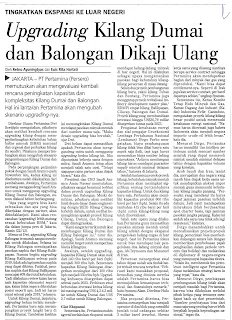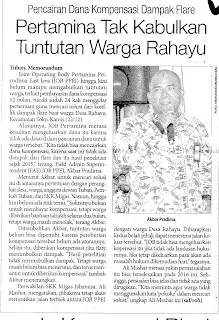PT Pertamina memutuskan akan mengevaluasi kembali rencana peningkatan kapasitas dan kompleksitas Kilang Dumai dan Balongan. Hal ini lantaran Pertamina akan mengubah skenario upgrading-nya. Direktur Utama Pertamina Dwi Soetjipto mengatakan, pihaknya akan melihat kembali rencana upgrading kilang dengan mempertimbangkan kebutuhan bahan bakar minyak nasional dan urgensi dari perbaikan kilang itu sendiri. Pihaknya mempertimbangkan akan mengubah skenario pengembangan Kilang Dumai dan Balongan.
Pada perpanjangan perjanjian pokok dengan Saudi Aramco pada November lalu, kedua kilang ini disebutnya sudah dikeluarkan dari pembahasan. Awalnya, Pertamina memang menggandeng Saudi Aramco untuk menggarap upgrading Kilang Dumai dan Balongan, namun diskusi belum berlangsung. Menurut Dwi, upgrading Kilang Balongan termasuk sangat mendesak untuk dilakukan. Selama ini Kilang Balongan mendapatkan pasokan naphta dari Kilang Balikpapan,
Namun begitu upgrading Kilang Balikpapan selesai pada 2019, tidak ada lagi pasokan naphta yang dapat dikirim. Padahal, pasokan naphta dari Kilang Balikpapan mencapai 40% dari total kebutuhan. Untuk Kilang Dumai, upgrading belum terlalu mendesak. Pertamina baru saja merampungkan proyek tangki baru di Kilang Dumai. Tambahan fasilitas ini memungkinkan Kilang Dumai mendapat pasokan minyak mentah dari sumber mana saja. “Maka desain upgrading bisa berubah," ujar Dwi. Dwi belum dapat memastikan apakah Pertamina akan menggandeng mitra untuk menggarap upgrading kedua kilang ini. Jika diputuskan bekerja sama dengan mitra, Saudi Aramco tetap akan menjadi salah satu opsi. "Tetapi siapapun calon partner akan diajak bicara,” kata dia.
President dan CEO Saudi Aramco Amin Nasser menyatakan, pihaknya sangat berminat terlibat dalam proyek upgrading Kilang Dumai dan Balongan. Meski demikian, pihaknya akan melihat hasil desain dasar (basic engineering design/ BED) Kilang Cilacap terlebih dahulu, untuk melihat kemungkinan apakah proyek Kilang Cilacap, Dumai, dan Balongan dapat diintegrasikan.
Awalnya, setelah upgrading, kapasitas Kilang Dumai akan naik dari 140 ribu barel per hari (bph) menjadi 300 ribu bph. Sementara
kapasitas Kilang Balongan ditargetkan meningkat dari 100 ribu bph menjadi 350 ribu bph.
Upgrading keduanya ditargetkan dapat selesai pada 2023. Perkiraan awal kebutuhan investasi kedua kilang ini masing-masing US$ 4,2-4,3 miliar untuk Kilang Dumai dan US$ 2,7 miliar untuk Kilang Balongan. Sementara itu, Pertamina makin agresif melakukan ekspansi untuk mendapat ladang-ladang minyak di luar negeri. Hal ini dilakukan sebagai upaya mengamankan pasokan bagi kebutuhan kilang-kilang perseroan di masa datang. Selain dua proyek pembangunan kilang baru, yakni kilang Tuban dan Bontang, Pertamina juga menggarap proyek revitalisasi (refinery development master plan/ RDMP) empat kilang, Balikpapan, Cilacap, Balongan dan Dumai. Proyek kilang yang membutuhkan investasi hingga US$ 36,79 miliar ditargetkan tuntas pada 2023.
Pengamat ketahanan energi dan staf pengajar Geoekonomi Lembaga Pertahanan Nasional (Lemhanas) Dirgo Purbo mengatakan, biaya pembangunan kilang tidak bisa dilihat hanya satu aspek saja fisik, tapi juga harus memasukan biaya sumber ladang minyaknya. Setelah tuntasnya proyek-proyek kilang, kebutuhan minyak mentah Pertamina akan meningkat signifikan seiring bertambahnya kapasitas kilang. Untuk dua kilang baru saja, Pertamina akan memiliki kapasitas produksi 600 ribu barel per hari (bph). Selain itu ada tambahan 415 ribu barel per hari (bph) untuk kilang-kilang yang telah direvitalisasi.
Salah satu upaya yang dilakukan Pertamina guna memastikan pasokan minyak mentah untuk kilang adalah dengan ekspansi pengelolaan ladang migas di luar negeri. Saat ini Pertamina fokus untuk bisa mendapat hak pengelolaan dua ladang minyak dan gas, Ab-Teymoura dan Mansouri di Iran. Perseroan menargetkan awal tahun depan sudah ada tindak lanjut terkait rencana tersebut. Februari kami masukkan proposal, kemudian yang diminta mereka adalah Pertamina harus bisa menunjukkan kemampuan technical, dan finansialnya menarik,” kata Syamsu Alam, Direktur Hulu Pertamina.
Jika proposal diterima, Pertamina menargetkan bisa menjadi operator di dua blok yang memiliki jumlah total cadangan sekitar 3 miliar barel tersebut. Skema kerja sama yang diusung nantinya berupa service contract sehingga Pertamina akan mendapatkan bagian dari minyak dan gas yang diproduksi. Kami bisa dapat entitlement-nya. Seperti di Irak juga kan service contract, per barel dapatnya sekian,” ungkap Syamsu. Sementara itu, Ketua Komite Tetap Hulu Minyak dan Gas, Kamar Dagang dan Industri (Kadin) Indonesia Firlie Ganinduto, mengatakan proyek kilang-kilang besar positif untuk memenuhi ketahanan energi nasional. “Namun harus dicermati juga bahwa Indonesia akan menjadi negara importir crude oil lebih besar,” kata dia.
Menurut Dirgo, Pertamina harus memiliki tim intelijen petroleum untuk mencari sumber minyak yang dapat memasok minyak mentah minimal delapan tahun dengan kapasitas volume yang konstan. Arab Saudi dan Iran, merupakan dua negara yang masih bisa diajak kerja sama untuk mendapatkan alokasi impor minyak guna memenuhi kebutuhan kilang jangka panjang. Persoalan yang mendasar itu harus dapat jaminan pasokan terlebih dahulu. Jadi nanti mendapatkan minyaknya tidak berdasarkan spot charter basis, tapi jaminan pasokan jangka panjang. Kalau ini sudah ada saya rasa tidak ada lagi resistensi,” katanya.
Dirgo menambahkan untuk merealisasikan proyek-proyek kilang, pemerintah bisa memberikan dukungan antara lain dengan memberikan pembebasan pajak penghasilan dalam periode tertentu (tax holiday) dan melakukan oil diplomacy di negara-negara yang mempunyai kapasitas ekstra. Selain itu, membentuk tim petroleum intelligent agar Pertamina dapat melakukan strategi farm in yang tepat,” kata dia.
Menurut Dirgo, pembiayaan pembangunan kilang tidak akan menjadi masalah bagi Pertamina, karena bisa dilakukan melalui pihak ketiga yang tentunya mendapat back up dari pemerintah. Sumber pembiayaan bisa dari mana saja yang penling harus lebih berpihak kepada kepentingan nasional.
IN ENGLISH
Dumai and Balongan Refinery Upgrading to Assess Longer
PT Pertamina decided to reevaluate the planned increase in capacity and complexity Dumai and Balongan refinery. This is because Pertamina will change its scenario upgrading. Pertamina President Director Dwi Soetjipto said it will look back at the refinery upgrading plan with the needs of national fuel and urgency of repairs refinery itself. He said he would consider changing the development scenario Dumai and Balongan refinery.
On the extension of the principal agreement with Saudi Aramco last November, the two refineries have called already excluded from the discussion. Initially, Pertamina is cooperating with Saudi Aramco to work on upgrading refinery Dumai and Balongan, but the discussion is not taking place. According to Dwi, upgrading refinery Balongan included are urgently required. During this time Balongan refinery naphtha obtain supplies from Balikpapan refinery,
Nevertheless upgrading Balikpapan refinery was completed in 2019, no further supply of naphtha that can be sent. In fact, the supply of naphtha from Balikpapan refinery reached 40% of total needs. For Dumai refinery, upgrading is not too urgent. Pertamina has just completed a new tank project in Dumai Refinery. This facility enables additional Dumai Refinery supply of crude oil received from any source. "So the design of upgrading can change," said Dwi. Dwi has not been able to verify whether Pertamina will invite partners to work on upgrading the refinery this. If it is decided to work with partners, Saudi Aramco will continue to be an option. "But whoever prospective partner will be invited talk, "he said.
President and CEO of Saudi Aramco Amin Nasser said his company is very interested in engaging in a refinery upgrading project Dumai and Balongan. Nevertheless, it would see the results of the basic design (basic engineering design / BED) Cilacap refinery in advance, to see whether the possibility of Cilacap refinery project, Dumai and Balongan can be integrated.
Initially, after upgrading, Dumai refinery capacity will rise from 140 thousand barrels per day (bpd) to 300 thousand bpd. While
Balongan refinery capacity is expected to increase from 100 thousand bpd to 350 thousand bpd.
Upgrading both targeted to be completed in 2023. Initial estimates of the investment needs of each refinery is US $ 4.2-4.3 billion for Dumai Refinery and US $ 2.7 billion for Balongan refinery. Meanwhile, Pertamina even more aggressive expansion to get the oil fields abroad. This is done in an effort to secure the supply for the needs of the company's refineries in the future. In addition to the two new refineries projects, namely Tuban refinery and Bontang, Pertamina is also working on revitalization projects (refinery development master plan / RDMP) four refineries, Balikpapan, Cilacap, Balongan and Dumai. Refinery project which requires an investment of up to US $ 36.79 billion expected to be completed in 2023.
Observers energy security and the teaching staff geoekonomi Institute of National Defense (Defense) Dirgo Purbo said the refinery construction costs can not be seen only one aspect of physical, but also must include the cost source of oil fields. After the completion of projects of refineries, Pertamina's crude oil needs will rise significantly with increasing refinery capacity. For just two refineries, Pertamina will have a production capacity of 600 thousand barrels per day (bpd). In addition there are an additional 415 thousand barrels per day (bpd) to refineries that have been revitalized.
One of the efforts carried out by Pertamina in order to ensure the supply of crude oil to the refinery expansion is the management of oil and gas fields abroad. Currently, Pertamina can get the right focus for the management of two oil and gas fields, Ab-Teymoura and Mansouri in Iran. The Company is targeting the start of next year has been no follow-up related to the plan. February we put in a proposal, then requested they are Pertamina should be able to demonstrate technical capability and financial interest, "said Syamsu Alam, Upstream Director of Pertamina.
If the proposal is accepted, Pertamina is targeting to become the operator in two blocks that have total reserves of about 3 billion barrels of it. Cooperation schemes promoted later in the form of service contract so that Pertamina will get a share of the oil and gas produced. We can get her entitlement. As in Iraq is also the service contract, barrel failure by so many, "said Syamsu. Meanwhile, Chairman of the Standing Committee of the Upstream Oil and Gas, Chamber of Commerce and Industry (Kadin) Indonesia Firlie Ganinduto, said the project were positive refineries to meet national energy security. "But it must be observed also that Indonesia would become a larger importer of crude oil," he said.
According Dirgo, Pertamina must have the intelligence team petroleum to find the source of the oil that can supply crude oil at least eight years with a constant volume capacity. Saudi Arabia and Iran are the two countries that they can deal with the allocation of oil imports in order to meet long-term needs of the refinery. The fundamental issue that must be able to guarantee supply in advance. So later get the oil is not based on the spot charter basis, but the long-term supply guarantees. If this has been there I think there is no more resistance, "he said.
Dirgo add to realize projects of refineries, the government can provide support include provision of the income tax exemption for a certain period (tax holiday) and doing oil diplomacy in countries that have extra capacity. In addition, petroleum intelligent form teams that Pertamina can farm in the proper strategy, "he said.
According Dirgo, financing the construction of the refinery will not be a problem for Pertamina, because it can be done through a third party that would get back up from the government. Financing sources can be from anywhere penling to be more aligned to national interests.
Investor Daily, Page-9, Friday, Dec, 23, 2016











